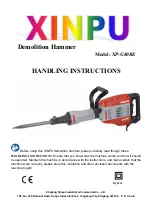
OPTIMUM
M A S C H I N E N - G E R M A N Y
Version 1.0.1 dated 2015-12-17
Page 71
Original operating instructions
MH25V
GB
4.11
Selecting the speed
The correct speed is an important factor for milling. The speed determines the cutting speed by
which the cutting edges cut the material. The service life of the tool can be increased and the
working result optimized by selecting the correct cutting speed.
The ideal cutting speed basically depends on the workpiece and the tool material. Higher
speeds are possible with tools (mills) made from hard metal or cutting ceramics than with tools
made from high-alloy high speed steel (HSS). You will achieve the ideal cutting speed by
selecting the correct rotation speed.
Please refer to the following standard values or a table reference book (e.g. Tabellenbuch Met-
all, Europa Lehrmittel, ISBN 3808517220) to determine the correct cutting speed for your tool
and the material to be cut.
The required speed is calculated as follows:
n = speed in rpm(revolutions per minute)
V = cutting speed in m/min (metres per minute)
d = tool diameter in m (metres)
4.11.1 Standard values for cutting speeds
[m/min] with high-speed steel and hard metal for upcut milling.
This results in the following standard speeds, dependent on
mill diameter, mill type and material.
n
V
π
d
×
------------
=
Tool
Steel
Grey cast iron
Al
alloy
case-hardened
Plain milling cutters and shell end mills [m/
min]
10 - 25
10 - 22
150 - 350
Relieved milling cutters [m/min]
15 - 24
10 - 20
150 - 250
Cutter head with SS [m/min]
15 - 30
12 - 25
200 - 300
Cutter head with HM [m/min]
100 - 200
30 - 100
300 - 400
Tool diameter
[mm] plain milling cutters and
shell end mills
Steel
10 - 25 m/min
Grey cast iron
10 - 22 m/min
Al alloy
case-hardened
150 - 350
m/min
Speed [rpm]
35
91 - 227
91 - 200
1365 - 3185
40
80 - 199
80 - 175
1195 - 2790
45
71 - 177
71 - 156
1062 - 2470
50
64 - 159
64 - 140
955 - 2230
55
58 - 145
58 - 127
870 - 2027
60
53 - 133
53 - 117
795 - 1860
65
49 - 122
49 - 108
735 - 1715
















































